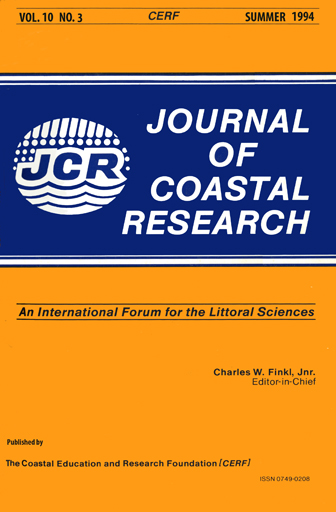Sediment Transport Patterns at the Essex River Inlet Ebb-Tidal Delta, Massachusetts, U.S.A.
Keywords:
Tidal inlet, ebb-tidal delta, sediment transport patterns, morphologic changes, sand circulation gyre, onshore bar migrationAbstract
Essex River Inlet is located along the Northern Massachusetts barrier chain between Castle Neck to the north and Coffins Beach to the south. The position of the inlet as well as the geometry of the backbarrier system are controlled by a pre-existing drainage system which, in turn, is strongly influenced by the bedrock topography. The inlet is fronted by a well developed ebb- tidal delta. The hydraulics, sediment transport patterns and morphological changes of the ebb-tidal delta have been investigated through the documentation and analysis of tidal- and wave-generated currents, grain size distributions, bedform migrational trends, swash bar development, and historical shoreline changes.
The inlet throat is increasingly dominated by ebb-tidal currents and seaward sediment transport as tidal range increases from mean towards spring tides. A similar trend exists in the marginal flood channels with increasingly stronger flood than ebb-tidal currents with increasing tidal range. These flow asymmetries explain the seaward- and inlet-oriented bedforms (sandwaves and megaripples) that floor these channels, respectively. The swash platform is dominated by landward currents and the onshore migration and coalescence of swash bars. The period of time between swash bar formation in the terminal lobe region and their eventual attachment to the landward beaches is approximately 5 to 7 years.
The channels and swash platform are parts of clockwise (updrift half of ebb-tidal delta) and counterclockwise (downdrift half of ebb-tidal delta) sediment gyres that circulate sand within the ebb-tidal delta and account for the sand that bypasses the inlet. Sediment transport rates determined using a variety of means (i.e. MADDOCK'S (1969) equation, swash bar migration data, morphological changes) indicate that the main ebb channel can easily remove the sand supplied from the marginal flood channels and across the channel margin linear bars. Moreover, calculated sand transport rates in the main ebb channel infer an order-of-magnitude, more sand is moved across the swash platform than is indicated by the migration of the swash bars. This suggests that far more sand is circulated within the sediment gyres than bypasses the inlet.


